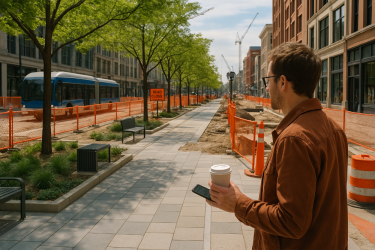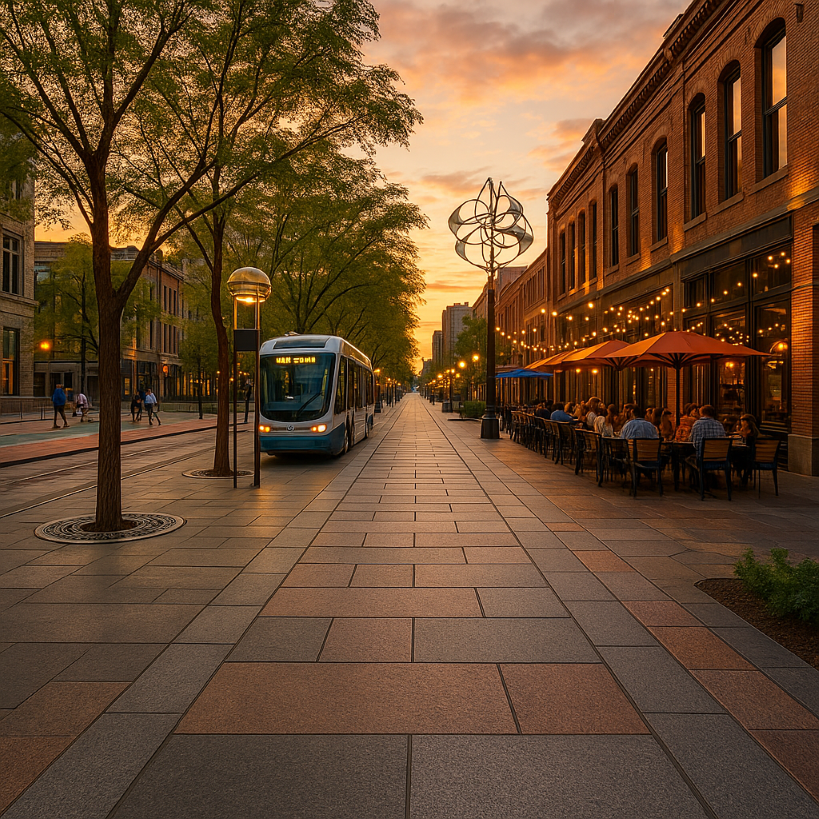Struggling to Revive Your Downtown? Denver’s 16th Street Mall Makeover Shows How

I never expected a coffee run to turn into an urban safari, but there I was on a blustery April morning, balancing a steaming latte in one hand and my phone in the other, when I stumbled onto the biggest makeover Denver’s downtown has seen in decades: the 16th Street Mall renovation. Here’s what unfolded as I wandered block by block—jotting notes in my head, chatting with shopkeepers, dodging orange cones—and accidentally charting the economic pulse of this reinvented pedestrian spine.
A few steps off the curb by Union Station, I clocked the first big change: the sidewalk had ballooned. Where I’d once squeezed past fellow strollers, now there was breathing room for a row of glossy black benches and a gleaming, bike-friendly lane hugged by newly planted honey locust trees. I paused to admire the bark’s pale mosaic, realizing these saplings are part of an on-site stormwater system: beneath each grate, a hidden bioswale filters rain, cutting runoff and giving every downpour a green purpose.

Drawn by the hum of saws and the scent of fresh concrete, I followed the shouts of workers near Curtis Street to the new center-running FreeRide shuttleway. Gone is the old, meandering MallRide; in its place, sleek, low-floor electric shuttles glide between Union and Civic Center without a single traffic light. I flagged down a driver for a quick chat. He beamed when I asked about ridership: “We’re seeing double the pre-pandemic numbers—almost 100,000 riders on a good day.” That explosion of foot and wheel traffic, he told me, is already translating to fatter till receipts for the cafés and boutiques lining each block.
By mid-morning I was wolfing down a breakfast burrito at the new wraparound patio outside a renovated taqueria near 15th and Lincoln. Five years ago, this was just a curbside bench; now there are fire pits and string lights, and on any given afternoon you’ll find remote workers camped out beneath umbrellas. I struck up a conversation with the restaurant’s owner, Maria, who’d weathered tight quarters and endless detours during Phase 1. “We invested in these outdoor tables expecting a small bump,” she said between sips of iced horchata. “But I’m seeing thirty percent more lunchtime covers—and that’s sustainable growth.”
As I folded my empty napkin, I took in the interplay of old and new: original Pei-designed pavers—those rosy flagstones you see in every postcard—bordered by crisp, light-gray granite slabs where underground utilities were upgraded. Every few feet, interactive plaques describe the block’s story: how storm sewers were replaced, electrical conduits rerouted, and fiber lines laid for future smart-city sensors. Watching folks tap their phones to learn more, I realized this plaza is part open-air museum, part living case study in infrastructure renewal.
A dozen blocks later, near 17th and Champa, my eyes locked on a “pocket park” carved out of what used to be a sidewalk curb. Kids dribbled basketballs on a micro-court. Office workers grabbed lunchtime shade beneath the canopy of mature maples. A local artist was installing a kinetic sculpture that twirled in the breeze—part of the Mall’s new public-art program. I stood back and counted the façades of refurbished heritage buildings: ornate brickwork freshened by LED uplighting, sleek glass storefronts that once sat empty, now occupied by co-working spaces and pop-up galleries.
It was impossible not to notice how property values have already ticked up. I overheard a real-estate broker brag to a prospective investor about a 15% ROI on ground-floor retail spaces, thanks largely to the jump in pedestrian counts and extended sidewalk cafés. A quick glance at my news feed later confirmed it: condo sales downtown are surging, and developers are unveiling mixed-use towers they’d shelved before the pandemic.
As the sun dipped toward the city skyline, I circled back near Civic Center Station, where Phase 2 crews were laying the final stretches of permeable pavers. Cranes hoisted massive tree-trench grates into place—an engineering marvel that channels groundwater to root systems while supporting foot traffic above. I dialed in on a group of passersby debating the project’s $175 million price tag. One woman said it was money well spent, citing the surge in downtown jobs and late-night foot traffic. Another wondered if the same funds might’ve done more for homelessness or public restrooms. Their candid exchange reminded me that great cities aren’t built on streetscapes alone—they evolve through spirited dialogue about where to invest our shared resources.
Walking away, I realized that this wasn’t just a facelift. It was a full-on vote of confidence in Denver’s urban core. Wider sidewalks have sparked patio economies; green infrastructure is a literal foundation for resilience; and safer, more reliable transit is knitting neighborhoods closer together. I’d set out for coffee and returned with a front-row seat to an economic revival, written in concrete, steel, and saplings.
Next time you swing by, look past the benches and buses. Notice the subtle choreography of design: the way light filters through the new canopy, how the pavers change texture underfoot, or how a single bioswale hums with unseen purpose. Behind every bench and beneath every tree is a vision of a city that’s ready for the next century—one pedestrian step at a time.